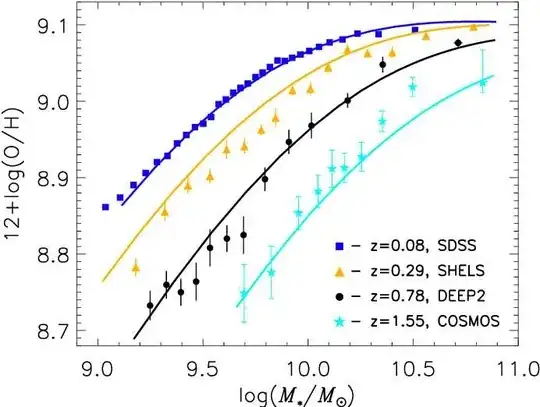Would the emission lines of a very distant galaxy show not many traces of heavier elements as that part of universe was very young? Or was there enough time for an abundance of heavier elements?
2 Answers
The short answer is yes, but the longer answer is more complex. There is a general trend that more distant galaxies are poorer in metals. However, there is a large scatter in such a relationship because age is not the only important parameter.
Figure 1, taken from Maolino & Mannuci (2018), but originally appearing in Zahid et al. (2014) shows the general trend that in well-defined redshift samples, more distant galaxies of the same mass are poorer in metals. i.e. You have to compare galaxies of similar mass. This is important because galaxies are probably built up from smaller building blocks and the average galaxy in the past is smaller than the average galaxy now and the overall mass of a galaxy appears to play a role (or perhaps the mergers of small galaxies play a role) in generating star formation and metal enrichment.
Figure 1: The dependence of oxygen abundance (on a logarithmic scale and as a proxy for metallicity) on galaxy mass for samples at increasing reshift. The data have been binned in mass producing rather smooth relationships. (From Zahid et al. 2014).
Taking studies to higher redshifts is difficult for several reasons. The galaxies are faint and adequate diagnostics of the metallicity, that can be observed consistently over a wide-range of redshifts, are hard to find. Additionally, it matters where in a galaxy you make the measurement, since there are gradients of metallicity within a galaxy. Observations of unresolved, distant galaxies can be difficult to compare with closer galaxies, especially if different tracers are being used because of the different redshifts.
Some progress can be made by studying Damped Lyman alpha Absorbers (DLAs) - clouds of gas/forming galaxies seen along sight lines to very high redshift quasars. Some of these have very low inferred metal abundances (almost down to a thousandth of solar at redshifts $>3$) and what is present appears to more enriched in the "alpha elements" (O, Mg, Si) that are primarily produced by short-lived massive stars and their type II supernovae explosions. Figure 2, taken from Berg et al. (2016), shows the logarithmic metal abundances (with respect to the Sun) of a set of DLAs from their work and the literature.
Figure 2: The metallicities (determined from a variety of diagnostics) for individual damped Lyman alpha absorber systems as a function of their redshift (from Berg et al. 2016).
A problem with trying to resolve the very beginnings of star formation and metal enrichment is that it tends to be massive star formation that makes it possible to see a galaxy. And because the first stages of enrichment, caused by the first short-lived massive stars and their supernovae, are fast, it is difficult to catch galaxies "in the act". Thus I think the answer to your question is that the observations of very high redshift galaxies ($z>5$) where we might hope to see the beginnings of enrichment with metals are still not good enough to trace this evolution.
This is an area where the James Webb Space Telescope (JWST) is expected to make a significant contribution. Its mid-infrared spectroscopy can probe metallicity indicators in distant galaxies with $z>5$ using diagnostics at the same rest-frame wavelengths that are probed by optical/near-IR telescopes at lower redshifts (e.g. the OIII and NII rest-frame optical emission lines) and with excellent spatial resolution and sensitivity (e.g. see this Science Case "white paper").
- 141,325
This is a very interesting question because the type of stars you are considering is called Population III stars. These stars are a hypothetical population added in 1978 and they should show no metal heavy elements. Such stars are assumed to have very high mass, from 100 solar masses, and very luminous. The presence of these population III stars is inferred from cosmological observations but they have not been directly detected.
- 42,352
- 338

